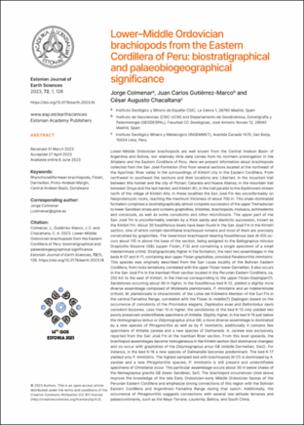Please use this identifier to cite or link to this item:
https://hdl.handle.net/20.500.12544/4913Lower–Middle Ordovician brachiopods from the Eastern Cordillera of Peru: biostratigraphical and palaeobiogeographical significance
Jun-2023
Estonian Journal of Earth Sciences, vol. 72, n.1, p. 126
Lower–Middle Ordovician brachiopods are well known from the Central Andean Basin of Argentina and Bolivia, but relatively little data comes from its northern prolongation in the Altiplano and the Eastern Cordillera of Peru. Here we present information about brachiopods collected from the San José Formation (Fm) from several sections located at the northeast of the Apurímac River valley in the surroundings of Kimbiri city in the Eastern Cordillera. From northwest to southeast the sections and their locations are: Libertad, in the mountain trail between this hamlet and the city of Pichari; Catarata and Nueva Alianza, in the mountain trail between Oroya and the last hamlet; and Kimbiri (K), in the trail parallel to the Kashiroveni stream north of the village of Kimbiri Alto. In these localities the San José Fm lies unconformably on Neoproterozoic rocks, reaching the maximum thickness of about 700 m. This shale-dominated formation comprises a biostratigraphically almost complete succession of the upper Tremadocian to lower Sandbian strata and contains graptolites, trilobites, brachiopods, molluscs, echinoderms and ostracods, as well as some conodonts and other microfossils. The upper part of the San José Fm is unconformably overlain by a thick sandy and diamictic succession, known as the Kimbiri Fm. About 30 fossiliferous levels have been found in the San José Fm in the Kimbiri section, nine of which contain identifiable brachiopod remains and most of them are precisely constrained by graptolites. The lowermost brachiopod-bearing fossiliferous bed (K-03) oc curs about 115 m above the base of the section, being assigned to the Baltograptus minutus Graptolite Biozone (GB) (upper Floian, Fl3) and containing a single specimen of a small indeterminate orthid. Stratigraphically higher in the formation, the next two assemblages in the beds K-07 and K-11, containing also upper Floian graptolites, provided Paralenorthis immitatrix. This species was originally described from the San Lucas locality of the Bolivian Eastern Cordillera, from rocks tentatively correlated with the upper Floian–lower Darriwilian. It also occurs in the San José Fm in the Inambari River section located in the Peruvian Eastern Cordillera, ca. 250 km to the east of Kimbiri, in the interval corresponding to the upper Floian–Dapingian(?). Sandstones occurring about 40 m higher, in the fossiliferous bed K-12, yielded a slightly more diverse assemblage composed of Mollesella planidorsalis, P. immitatrix and an indeterminate orthoid. M. planidorsalis is characteristic of the Loma del Kilómetro Member of the Suri Fm in the central Famatina Range, correlated with the Floian to middle(?) Dapingian based on the occurrence of conodonts of the Prioniodus elegans, Oepikodus evae and Baltoniodus navis conodont biozones. Less than 10 m higher, the sandstones of the bed K-13 only yielded two poorly preserved unidentifiable specimens of Ahtiella. Slightly higher, in the bed K-15 just below the Holmograptus lentus or Didymograptus artus GB, a more diverse assemblage is dominated by a new species of Phragmorthis as well as by P. immitatrix; additionally it contains few specimens of Ahtiella zarelae and a new species of Dalmanella. A. zarelae was exclusively reported from the San José Fm at the Inambari River section. From this level upwards, the brachiopod assemblages become homogeneous in the Kimbiri section (but dominance changes) and co-occur with graptolites of the Didymograptus artus GB (middle Darriwilian, Dw2). For instance, in the bed K-16 a new species of Dalmanella becomes predominant. The bed K-17 yielded only P. immitatrix. The highest sampled bed with brachiopods (K-21) is dominated by A. zarelae and a new Phragmorthis species, P. immitatrix is still present and unidentifiable specimens of Christiania occur. This particular assemblage occurs about 30 m below shales of the Nemagraptus gracilis GB (lower Sandbian, Sa1). The brachiopod occurrences cited above improve the knowledge of the late Early Ordovician–early Middle Ordovician faunas of the Peruvian Eastern Cordillera and emphasize strong connections of this region with the Bolivian Eastern Cordillera and Argentinian Famatina Range during that epoch. Additionally, the occurrence of Phragmorthis suggests connections with several low-latitude terranes and palaeocontinents, such as the Mayo Terrane, Laurentia, Baltica, and South China.
Estonian Academy Publishers
Colmenar, J.; Gutiérrez, J. & Chacaltana, C. (2023). Lower–Middle Ordovician brachiopods from the Eastern Cordillera of Peru: biostratigraphical and palaeobiogeographical significance. Estonian Journal of Earth Sciences, 72(1): 126. https://doi.org/10.3176/earth.2023.16
1 página
Files in This Item:
| File | Description | Size | Format | |
|---|---|---|---|---|
| Colmenar-Lower–Middle Ordovician.pdf | Artículo científico | 886.97 kB | Adobe PDF | View/Open |
This item is licensed under a Creative Commons License












